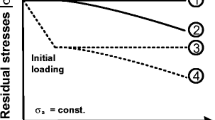Abstract
Forming processes generally lead to residual stresses. Compressive residual stresses can have a beneficial impact on the fatigue life of components, which is demonstrated here in terms of a skew-rolled hybrid shaft-hub connection. In order to set the basis for a systematic investigation of this effect, a strategy for the evaluation of the influence of residual stresses on the fatigue resistance of formed components is proposed. It involves the determination of the expectable residual stresses through a simulation of the forming process as well as a fatigue analysis. While state-of-the-art fatigue concepts assume unchanging cyclic material behaviour throughout the entire fatigue life of the component, this assumption is not adequate for residual stress-afflicted components. Hence, a generalization to transient cyclic material behaviour with an asymmetry in tension and compression is introduced.






















Similar content being viewed by others
References
Beghini M, Bertini L, Monelli BD, Santus C, Bandini M (2014) Experimental parameter sensitivity analysis of residual stresses induced by deep rolling on 7075–T6 aluminium alloy. Surf Coat Technol 254:175–186. https://doi.org/10.1016/j.surfcoat.2014.06.008
Blasón S, Rodríguez C, Belzunce J, Suárez C (2017) Fatigue behaviour improvement on notched specimens of two different steels through deep rolling, a surface cold treatment. Theor Appl Fract Mech 92:223–228. https://doi.org/10.1016/j.tafmec.2017.08.003
Brinksmeier E, Cammett JT, König W, Leskovar P, Peters J, Tönshoff HK (1982) Residual stresses measurement and causes in machining processes. CIRP Ann 31(2):491–510. https://doi.org/10.1016/S0007-8506(07)60172-3
Bruschi S, Altan T, Banabic D, Bariani PF, Brosius A, Cao J, Ghiotti A, Khraisheh M, Merklein M, Tekkaya AE (2014) Testing and modelling of material behaviour and formability in sheet metal forming. CIRP Ann 63(2):727–749. https://doi.org/10.1016/j.cirp.2014.05.005
Buxbaum O, Lowak H (1983) Zur Steigerung der Schwingfestigkeit durch mechanisch erzeugte Druckeigenspannungen. Materialwissenschaft und Werkstofftechnik 14(12):421–428. https://doi.org/10.1002/mawe.19830141209
Coffin LFJ, Schenectady NY (1954) A study of the effects of cyclic thermal stresses on a ductile metal. Trans Am Soc Mech Eng 76:931–950
Delgado P, Cuesta II, Alegre JM, Daz A (2016) State of the art of Deep Rolling. Precis Eng 46:1–10. https://doi.org/10.1016/j.precisioneng.2016.05.001
Jang DY, Liou JH (1998) Study of stress development in axi-symmetric products processed by radial forging using a 3-D non-linear finite-element method. J Materials Process Technol 74(1):74–82. https://doi.org/10.1016/S0924-0136(97)00252-5
Kloos KH (1979) Eigenspannungen, definition und entstehungsursachen. Materialwissenschaft und Werkstofftechnik 10(9):293–302. https://doi.org/10.1002/mawe.19790100906
Kloos KH (1995) Größeneinfluss. Einfluss der Probengröße auf das Ermüdungsverhalten bauteilähnlicher Kerbproben unter einstufigen und zufallsartigen Beanspruchsabläufen. In: Abschlussbericht Vorhaben Nr. 145-2, vol. 192. Forschungskuratorium Maschinenbau e.V
Kromm A (2011) Umwandlungsverhalten und Eigenspannungen beim Schweißen neuartiger LTT-Zusatzwerkstoffe. BAM-Dissertationsreihe. BAM
Lan J, Feng S, Hua L (2017) The residual stress of the cold rolled bearing race. Procedia Eng 207:1254–1259. https://doi.org/10.1016/j.proeng.2017.10.879
Manson SS (1965) Fatigue: a complex subject—some simple approximations. Exp Mech 5(4):193–226. https://doi.org/10.1007/BF02321056
Masing G (1926) Eigenspannungen und Verfestigung beim Messing. In: Proc. 2nd Int. Cong. of Appl. Mech., pp 332–335
Merklein M, Andreas K, Engel U (2011) Influence of machining process on residual stresses in the surface of cemented carbides. Procedia Eng 19:252–257. https://doi.org/10.1016/j.proeng.2011.11.108
Miner MA (1945) Cumulative damage in fatigue. J Appl Mech 12(3):159–164
Morrow J (1965) Cyclic Plastic Strain Energy and Fatigue of Metals. In: Lazan, B. (ed.) Internal Friction, Damping, and Cyclic Plasticity, pp. 45–45–43. ASTM International, 100 Barr Harbor Drive, PO Box C700, West Conshohocken, PA 19428-2959. https://doi.org/10.1520/STP43764S
Neuber H (1961) Theory of stress concentration for shear-strained prismatical bodies with arbitrary nonlinear stress-strain law. J Appl Mech 28(4):544–550. https://doi.org/10.1115/1.3641780
Palmgren A (1924) Die lebensdauer von kugellagern. Zeitschrift des Vereins Deutscher Ingenieure 68(14):339–341
Pineau A, McDowell DL, Busso EP, Antolovich SD (2016) Failure of metals II: fatigue. Acta Materialia 107:484–507. https://doi.org/10.1016/j.actamat.2015.05.050
Pintschovius L (1992) Macrostresses, microstresses and stress tensors. In: Hutchings MT, Krawitz AD (eds) Measurement of residual and applied stress using neutron diffraction. Springer, Dordrecht, pp 115–130
Radaj D (1990) Design and analysis of fatigue resistant welded structures. In: Welding and Other Joining Technologies. Woodhead Publishing Ltd, Cambridge
Radaj D, Vormwald M (2007) Ermüdungsfestigkeit, 3 edn. Springer Berlin Heidelberg, Berlin, Heidelberg. https://doi.org/10.1007/978-3-540-71459-0
Ramberg W, Osgood W (1943) Description of stress-strain curves by three parameters. NACA Technical Note 902
Reiss A, Engel U, Merklein M (2013) Investigation on the influence of manufacturing parameters on the fatigue strength of components. Key Eng Mater 554–557:280–286. https://doi.org/10.4028/www.scientific.net/KEM.554-557.280
Rudkins NT, Modlen GF, Webster PJ (1994) Residual stresses in cold extrusion and cold drawing: a finite element and neutron diffraction study. J Materials Process Technol 45(1):287–292. https://doi.org/10.1016/0924-0136(94)90354-9
Ruud CO (2000) Residual Stress Measurements. In: ASM Handbook, vol. 8, pp. 886–904. ASM International
Smith DJ, Farrahi GH, Zhu WX, McMahon CA (2001) Experimental measurement and finite element simulation of the interaction between residual stresses and mechanical loading. Int J Fatigue 23(4):293–302. https://doi.org/10.1016/S0142-1123(00)00104-3
Smith KN, Topper T, Watson P (1970) A stress-strain function for the fatigue of metals. J Materials 5:767–778
Socie DF (1977) Fatigue-life prediction using local stress-strain concepts. Exp Mech 17:50. https://doi.org/10.1007/BF02326426
Tekkaya AE (1986) Ermittlung von eigenspannungen in der kaltmassivumformung. Springer, Berlin
Tscheuschner T, Schomäcker M, Brosius A (2016) Fügen hybrider rotationsymmetrischer Bauteile durch Profil-Axial-Walzen. Tagungsband zur 23. Sächsische Fachtagung Umformtechnik SFU 2016, 7.-8.12.2016, Dresden
Acknowledgements
Funded by the Deutsche Forschungsgemeinschaft (DFG, German Research Foundation) within the Priority Program 2013 “Targeted Use of Forming Induced Residual Stresses in Metal Components” under the grant numbers KA 3309/7-1 and BR 3500/21-1.
Author information
Authors and Affiliations
Corresponding author
Rights and permissions
About this article
Cite this article
Kühne, D., Guilleaume, C., Seiler, M. et al. Fatigue analysis of rolled components considering transient cyclic material behaviour and residual stresses. Prod. Eng. Res. Devel. 13, 189–200 (2019). https://doi.org/10.1007/s11740-018-0861-9
Received:
Accepted:
Published:
Issue Date:
DOI: https://doi.org/10.1007/s11740-018-0861-9




